Integrated Assessment of Economic Supply and Environmental Effects of Biomass Co-Firing in Coal Power Plants: A Case Study of Jiangsu, China
Abstract
1. Introduction
2. Simulation Model
3. GHG Savings with Biopower
4. Data
4.1. Crop Production
4.2. Residue Production
4.3. Co-Firing Capacity
5. Results and Discussion
5.1. Supply of Crop Residues
5.2. Spatial Distribution of Crop Residues and Logistics
5.3. GHG Implications
5.4. Social Benefits of Biomass Co-Firing
5.5. Sensitivity Analysis
6. Discussion
7. Conclusions
Supplementary Materials
Funding
Data Availability Statement
Acknowledgments
Conflicts of Interest
Nomenclature
| CO2 | carbon dioxide | emission factor of coal-based electricity | |
| CGE | computable general equilibrium | emission from biopower | |
| GHG | greenhouse gases | farm gate GHG emission | |
| JPBS | Jiangsu Province Bureau of Statistics | GHG emission with preprocessing of biomass | |
| kWh | kilowatt-hour | GHG emission with biomass transportation | |
| IAM | integrated assessment model | GHG emission with burning biomass for electricity generation | |
| PE | partial equilibrium | net GHG saving | |
| M | million | GHG emission with coal-based electricity at the non-zero-biomass price | |
| MW | megawatt | GHG emission with coal-based electricity at the zero-biomass price | |
| M MT | million metric ton | avoided emissions from residue open burning | |
| EJ | exajoule | total amount of coal-based electricity | |
| GT/year | gigatons per year | Parameters | |
| USD/MT | dollars per metric ton | p | biomass price |
| ha | hectare | production cost of crop per unit of land in county r | |
| MMBTU/MT | million British thermal units per metric ton | residue cost per unit of collected residue in county r | |
| MJ/kg | megajoule per kilogram | yield of crop per unit of land in county r | |
| BTU/hr | British thermal units per hour | total land availability in county r | |
| gCO2e | grams of carbon dioxide equivalent | historical planted acreage for crop in county r and year hy | |
| g CH4/kg | grams of methane per kilogram | biomass–coal co-firing ratio | |
| g N2O/kg | grams of nitrous oxide per kilogram | relative calorific value of biomass | |
| M MT CO2e | million metric ton of carbon dioxide equivalent | caloric value of coal | |
| km | kilometer | caloric value of biomass | |
| Variables | heat input of facility k | ||
| BMASSi,r | collected crop residues for crop in county r | total number of operating hours (in hr/year) | |
| Qi | domestic demand for crop | nameplate capacity of facility k in MW | |
| Pi(q) | inverse domestic demand function for crop | capacity factor of facility k | |
| Li,r | planted acreage allocated to crop in county r | efficiency rate of facility k | |
| LRi,r | land under which crop residue are collected for crop in county r | c | unit conversion factor from MW to BTU/hr |
| share of row crop in county r | biomass burning efficiency | ||
| weight for crop in county r and year hy in convex combination | emission factor for burning crop residues | ||
| amount of co-firing crop residues consumed by facility k sourced from county r and type | global warming potential | ||
References
- Yang, H.; Huang, X.; Hu, J.; Thompson, J.R.; Flower, R.J. Achievements, Challenges and Global Implications of China’s Carbon Neutral Pledge. Front. Environ. Sci. Eng. 2022, 16, 111. [Google Scholar] [CrossRef] [PubMed]
- National Energy Administration. National Renewable Energy Power Development Monitoring and Evaluation Report. 2021. Available online: http://www.nea.gov.cn/2022-09/16/c_1310663387.htm (accessed on 26 November 2022). (In Chinese)
- Cui, R.Y.; Hultman, N.; Cui, D.; McJeon, H.; Yu, S.; Edwards, M.R.; Sen, A.; Song, K.; Bowman, C.; Clarke, L.; et al. A Plant-by-Plant Strategy for High-Ambition Coal Power Phaseout in China. Nat. Commun. 2021, 12, 1468. [Google Scholar] [CrossRef] [PubMed]
- Liu, J.; Wang, Q.; Song, Z.; Fang, F. Bottlenecks and Countermeasures of High-Penetration Renewable Energy Development in China. Engineering 2021, 7, 1611–1622. [Google Scholar] [CrossRef]
- Lu, X.; Cao, L.; Wang, H.; Peng, W.; Xing, J.; Wang, S.; Cai, S.; Shen, B.; Yang, Q.; Nielsen, C.P.; et al. Gasification of Coal and Biomass as a Net Carbon-Negative Power Source for Environment-Friendly Electricity Generation in China. Proc. Natl. Acad. Sci. USA 2019, 116, 8206–8213. [Google Scholar] [CrossRef]
- IEA. An Energy Sector Roadmap to Carbon Neutrality in China; OECD Publishing: Paris, France, 2021. [Google Scholar]
- National Bureau of Statistics of China. China Energy Statistical Yearbook. 2021. Available online: Https://Data.Cnki.Net/Trade/Yearbook/Single/N2021050066?Zcode=Z023 (accessed on 3 December 2022).
- Zhang, Q.; Zhou, D.; Zhou, P.; Ding, H. Cost Analysis of Straw-Based Power Generation in Jiangsu Province, China. Appl. Energy 2013, 102, 785–793. [Google Scholar] [CrossRef]
- Netherlands Enterprise Agency. Sector Report Biomass Energy in Jiangsu Province. 2015. Available online: Www.Rvo.Nl. (accessed on 19 January 2023).
- Xu, Y.; Yang, K.; Zhou, J.; Zhao, G. Coal-Biomass Co-Firing Power Generation Technology: Current Status, Challenges and Policy Implications. Sustainability 2020, 12, 3692. [Google Scholar] [CrossRef]
- Nguyen, T.H.; Field, J.L.; Kwon, H.; Hawkins, T.R.; Paustian, K.; Wang, M.Q. A Multi-Product Landscape Life-Cycle Assessment Approach for Evaluating Local Climate Mitigation Potential. J. Clean. Prod. 2022, 354, 131691. [Google Scholar] [CrossRef]
- Yuan, Y.; Zhao, J. Study on the Supply Capacity of Crop Residue as Energy in Rural Areas of Heilongjiang Province of China. Renew. Sustain. Energy Rev. 2014, 38, 526–536. [Google Scholar] [CrossRef]
- Shu, K.; Schneider, U.; Scheffran, J. Bioenergy and Food Supply: A Spatial-Agent Dynamic Model of Agricultural Land Use for Jiangsu Province in China. Energies 2015, 8, 13284–13307. [Google Scholar] [CrossRef]
- Wu, J.; Zhang, J.; Yi, W.; Cai, H.; Li, Y.; Su, Z. Agri-Biomass Supply Chain Optimization in North China: Model Development and Application. Energy 2022, 239, 122374. [Google Scholar] [CrossRef]
- Xue, S.; Lewandowski, I.; Wang, X.; Yi, Z. Assessment of the Production Potentials of Miscanthus on Marginal Land in China. Renew. Sustain. Energy Rev. 2016, 54, 932–943. [Google Scholar] [CrossRef]
- Qiu, H.; Sun, L.; Xu, X.; Cai, Y.; Bai, J. Potentials of Crop Residues for Commercial Energy Production in China: A Geographic and Economic Analysis. Biomass Bioenergy 2014, 64, 110–123. [Google Scholar] [CrossRef]
- Zhang, B.; Xu, J.; Lin, Z.; Lin, T.; Faaij, A.P.C. Spatially Explicit Analyses of Sustainable Agricultural Residue Potential for Bioenergy in China under Various Soil and Land Management Scenarios. Renew. Sustain. Energy Rev. 2021, 137, 110614. [Google Scholar] [CrossRef]
- Qin, Z.; Zhuang, Q.; Cai, X.; He, Y.; Huang, Y.; Jiang, D.; Lin, E.; Liu, Y.; Tang, Y.; Wang, M.Q. Biomass and Biofuels in China: Toward Bioenergy Resource Potentials and Their Impacts on the Environment. Renew. Sustain. Energy Rev. 2018, 82, 2387–2400. [Google Scholar] [CrossRef]
- Kang, Y.; Yang, Q.; Bartocci, P.; Wei, H.; Liu, S.S.; Wu, Z.; Zhou, H.; Yang, H.; Fantozzi, F.; Chen, H. Bioenergy in China: Evaluation of Domestic Biomass Resources and the Associated Greenhouse Gas Mitigation Potentials. Renew. Sustain. Energy Rev. 2020, 127, 109842. [Google Scholar] [CrossRef] [PubMed]
- Xing, X.; Wang, R.; Bauer, N.; Ciais, P.; Cao, J.; Chen, J.; Tang, X.; Wang, L.; Yang, X.; Boucher, O.; et al. Spatially Explicit Analysis Identifies Significant Potential for Bioenergy with Carbon Capture and Storage in China. Nat. Commun. 2021, 12, 3159. [Google Scholar] [CrossRef]
- Chen, X. Economic Potential of Biomass Supply from Crop Residues in China. Appl. Energy 2016, 166, 141–149. [Google Scholar] [CrossRef]
- Fang, Y.R.; Shi, W.; Xie, G.H. Implications of Wheat Straw Logistic Systems for Bioenergy Sustainable Development in China: Costs, Energy Consumption, and GHG Emissions. Sci. Total Environ. 2022, 837, 155633. [Google Scholar] [CrossRef] [PubMed]
- Li, J.; Wang, R.; Li, H.; Nie, Y.; Song, X.; Li, M.; Shi, M.; Zheng, X.; Cai, W.; Wang, C. Unit-Level Cost-Benefit Analysis for Coal Power Plants Retrofitted with Biomass Co-Firing at a National Level by Combined GIS and Life Cycle Assessment. Appl. Energy 2021, 285, 116494. [Google Scholar] [CrossRef]
- Hudiburg, T.W.; Wang, W.; Khanna, M.; Long, S.P.; Dwivedi, P.; Parton, W.J.; Hartman, M.; DeLucia, E.H. Impacts of a 32-Billion-Gallon Bioenergy Landscape on Land and Fossil Fuel Use in the US. Nat. Energy 2016, 1, 15005. [Google Scholar] [CrossRef]
- Masum, F.H.; Wang, W.; Colson, G.; Dwivedi, P. Replacing Coal in Georgia’s Power Plants with Woody Biomass to Increase Carbon Benefit: A Mixed Integer Linear Programming Model. J. Environ. Manag. 2022, 316, 115060. [Google Scholar] [CrossRef] [PubMed]
- Wang, W.; Dwivedi, P.; Abt, R.; Khanna, M. Carbon Savings with Transatlantic Trade in Pellets: Accounting for Market-Driven Effects. Environ. Res. Lett. 2015, 10, 114019. [Google Scholar] [CrossRef]
- Searchinger, T.; James, O.; Dumas, P.; Kastner, T.; Wirsenius, S. EU Climate Plan Sacrifices Carbon Storage and Biodiversity for Bioenergy. Nature 2022, 612, 27–30. [Google Scholar] [CrossRef] [PubMed]
- DeCicco, J.M.; Schlesinger, W.H. Reconsidering Bioenergy given the Urgency of Climate Protection. Proc. Natl. Acad. Sci. USA 2018, 115, 9642–9645. [Google Scholar] [CrossRef] [PubMed]
- Liska, A.J.; Yang, H.; Milner, M.; Goddard, S.; Blanco-Canqui, H.; Pelton, M.P.; Fang, X.X.; Zhu, H.; Suyker, A.E. Biofuels from Crop Residue Can Reduce Soil Carbon and Increase CO2 Emissions. Nat. Clim. Chang. 2014, 4, 398–401. [Google Scholar] [CrossRef]
- Mandley, S.; Wicke, B.; Junginger, H.; Vuuren, D.; Daioglou, V. Integrated Assessment of the Role of Bioenergy within the EU Energy Transition Targets to 2050. GCB Bioenergy 2022, 14, 157–172. [Google Scholar] [CrossRef]
- Appiah-Nkansah, N.B.; Li, J.; Rooney, W.; Wang, D. A Review of Sweet Sorghum as a Viable Renewable Bioenergy Crop and Its Techno-Economic Analysis. Renew. Energy 2019, 143, 1121–1132. [Google Scholar] [CrossRef]
- Nandimandalam, H.; Gude, V.G. Renewable Wood Residue Sources as Potential Alternative for Fossil Fuel Dominated Electricity Mix for Regions in Mississippi: A Techno-Economic Analysis. Renew. Energy 2022, 200, 1105–1119. [Google Scholar] [CrossRef]
- Agbor, E.; Oyedun, A.O.; Zhang, X.; Kumar, A. Integrated Techno-Economic and Environmental Assessments of Sixty Scenarios for Co-Firing Biomass with Coal and Natural Gas. Appl. Energy 2016, 169, 433–449. [Google Scholar] [CrossRef]
- Natelson, R.H.; Wang, W.-C.; Roberts, W.L.; Zering, K.D. Technoeconomic Analysis of Jet Fuel Production from Hydrolysis, Decarboxylation, and Reforming of Camelina Oil. Biomass Bioenergy 2015, 75, 23–34. [Google Scholar] [CrossRef]
- Moioli, E.; Schildhauer, T. Eco-Techno-Economic Analysis of Methanol Production from Biogas and Power-to-X. Ind. Eng. Chem. Res. 2022, 61, 7335–7348. [Google Scholar] [CrossRef]
- Zetterholm, J.; Bryngemark, E.; Ahlström, J.; Söderholm, P.; Harvey, S.; Wetterlund, E. Economic Evaluation of Large-Scale Biorefinery Deployment: A Framework Integrating Dynamic Biomass Market and Techno-Economic Models. Sustainability 2020, 12, 7126. [Google Scholar] [CrossRef]
- Hanssen, S.V.; Daioglou, V.; Steinmann, Z.J.N.; Frank, S.; Popp, A.; Brunelle, T.; Lauri, P.; Hasegawa, T.; Huijbregts, M.A.J.; Van Vuuren, D.P. Biomass Residues as Twenty-First Century Bioenergy Feedstock—A Comparison of Eight Integrated Assessment Models. Clim. Chang. 2020, 163, 1569–1586. [Google Scholar] [CrossRef] [PubMed]
- Pan, X.; Chen, W.; Wang, L.; Lin, L.; Li, N. The Role of Biomass in China’s Long-Term Mitigation toward the Paris Climate Goals. Environ. Res. Lett. 2018, 13, 124028. [Google Scholar] [CrossRef]
- Chen, X.; Huang, H.; Khanna, M.; Önal, H. Alternative Transportation Fuel Standards: Welfare Effects and Climate Benefits. J. Environ. Econ. Manag. 2014, 67, 241–257. [Google Scholar] [CrossRef]
- Ekşioğlu, S.D.; Karimi, H.; Ekşioğlu, B. Optimization Models to Integrate Production and Transportation Planning for Biomass Co-Firing in Coal-Fired Power Plants. IIE Trans. 2016, 48, 901–920. [Google Scholar] [CrossRef]
- Phanphanich, M.; Mani, S. Impact of Torrefaction on the Grindability and Fuel Characteristics of Forest Biomass. Bioresour. Technol. 2011, 102, 1246–1253. [Google Scholar] [CrossRef]
- Lizotte, P.-L.; Savoie, P.; De Champlain, A. Ash Content and Calorific Energy of Corn Stover Components in Eastern Canada. Energies 2015, 8, 4827–4838. [Google Scholar] [CrossRef]
- IEA Bioenergy Annual Report 2021. 2022. Available online: Https://Www.Ieabioenergy.Com/Blog/Publications/Iea-Bioenergy-Annual-Report-2021/ (accessed on 17 January 2023).
- Baker, J.S.; Wade, C.M.; Sohngen, B.L.; Ohrel, S.; Fawcett, A.A. Potential Complementarity between Forest Carbon Sequestration Incentives and Biomass Energy Expansion. Energy Policy 2019, 126, 391–401. [Google Scholar] [CrossRef]
- Feng, K.; Hubacek, K.; Siu, Y.L.; Li, X. The Energy and Water Nexus in Chinese Electricity Production: A Hybrid Life Cycle Analysis. Renew. Sustain. Energy Rev. 2014, 39, 342–355. [Google Scholar] [CrossRef]
- Masum, M.F.H.; Dwivedi, P.; Anderson, W.F. Estimating Unit Production Cost, Carbon Intensity, and Carbon Abatement Cost of Electricity Generation from Bioenergy Feedstocks in Georgia, United States. Renew. Sustain. Energy Rev. 2020, 117, 109514. [Google Scholar] [CrossRef]
- Guo, S. How Does Straw Burning Affect Urban Air Quality in China? Am. J. Agric. Econ. 2021, 103, 1122–1140. [Google Scholar] [CrossRef]
- Liang, D.; Lu, X.; Zhuang, M.; Shi, G.; Hu, C.; Wang, S.; Hao, J. China’s Greenhouse Gas Emissions for Cropping Systems from 1978–2016. Sci. Data 2021, 8, 171. [Google Scholar] [CrossRef] [PubMed]
- IPCC. Climate Change 2013: The Physical Science Basis; Cambridge University Press: Cambridge, UK; New York, NY, USA, 2013. [Google Scholar]
- Graham, R.L.; Nelson, R.; Sheehan, J.; Perlack, R.D.; Wright, L.L. Current and Potential U.S. Corn Stover Supplies. Agron. J. 2007, 99, 1–11. [Google Scholar] [CrossRef]
- Sheehan, J.; Aden, A.; Paustian, K.; Killian, K.; Brenner, J.; Walsh, M.; Nelson, R. Energy and Environmental Aspects of Using Corn Stover for Fuel Ethanol. J. Ind. Ecol. 2003, 7, 117–146. [Google Scholar] [CrossRef]
- Lal, R. World Crop Residues Production and Implications of Its Use as a Biofuel. Environ. Int. 2005, 31, 575–584. [Google Scholar] [CrossRef]
- Malcolm, S. Weaning off Corn: Crop Residues and the Transition to Cellulosic Ethanol. In The Transition to a BioEconomy: Environmental and Rural Development Impacts, Proceedings of the Environmental and Rural Development Impacts Conference, St. Louis, MO, USA, 15–16 October 2008; Farm Foundation: Oak Brook, IL, USA, 2008. [Google Scholar]
- Liu, Z.; Altman, I.; Johnson, T.G. The Feasibility of Co-Firing Biomass for Electricity in Missouri. Biomass Bioenergy 2014, 69, 12–20. [Google Scholar] [CrossRef]
- Chen, J.; Gong, Y.; Wang, S.; Guan, B.; Balkovic, J.; Kraxner, F. To Burn or Retain Crop Residues on Croplands? An Integrated Analysis of Crop Residue Management in China. Sci. Total Environ. 2019, 662, 141–150. [Google Scholar] [CrossRef]
- Argonne National Laboratory. 2020; GREET Model. Available online: https://greet.es.anl.gov (accessed on 1 August 2021).
- Huang, J.; Jun, Y.; Xu, Z.; Rozelle, S.; Li, N. Agricultural trade liberalization and poverty in China. China Econ. Rev. 2007, 18, 244–265. [Google Scholar] [CrossRef]
- Jin, Z.; Shah, T.; Zhang, L.; Liu, H.; Peng, S.; Nie, L. Effect of straw returning on soil organic carbon in rice–wheat rotation system: A review. Food Energy Secur. 2020, 9. [Google Scholar] [CrossRef]
- Obnamia, J.A.; Dias, G.M.; MacLean, H.L.; Saville, B.A. Comparison of U.S. Midwest corn stover ethanol greenhouse gas emissions from GREET and GHGenius. Appl. Energy 2019, 235, 591–601. [Google Scholar] [CrossRef]
- WDNR. Forest Biomass and Air Emission. Washington State Department of Natural Resources. 2010. Available online: https://www.dnr.wa.gov/Publications/em_forest_biomass_and_air_emissions_factsheet_7.pdf. (accessed on 24 January 2023).
- Zhao, L.; Ou, X.; Chang, S. Life-cycle greenhouse gas emission and energy use of bioethanol produced from corn stover in China: Current perspectives and future prospectives. Energy 2016, 115, 303–313. [Google Scholar] [CrossRef]


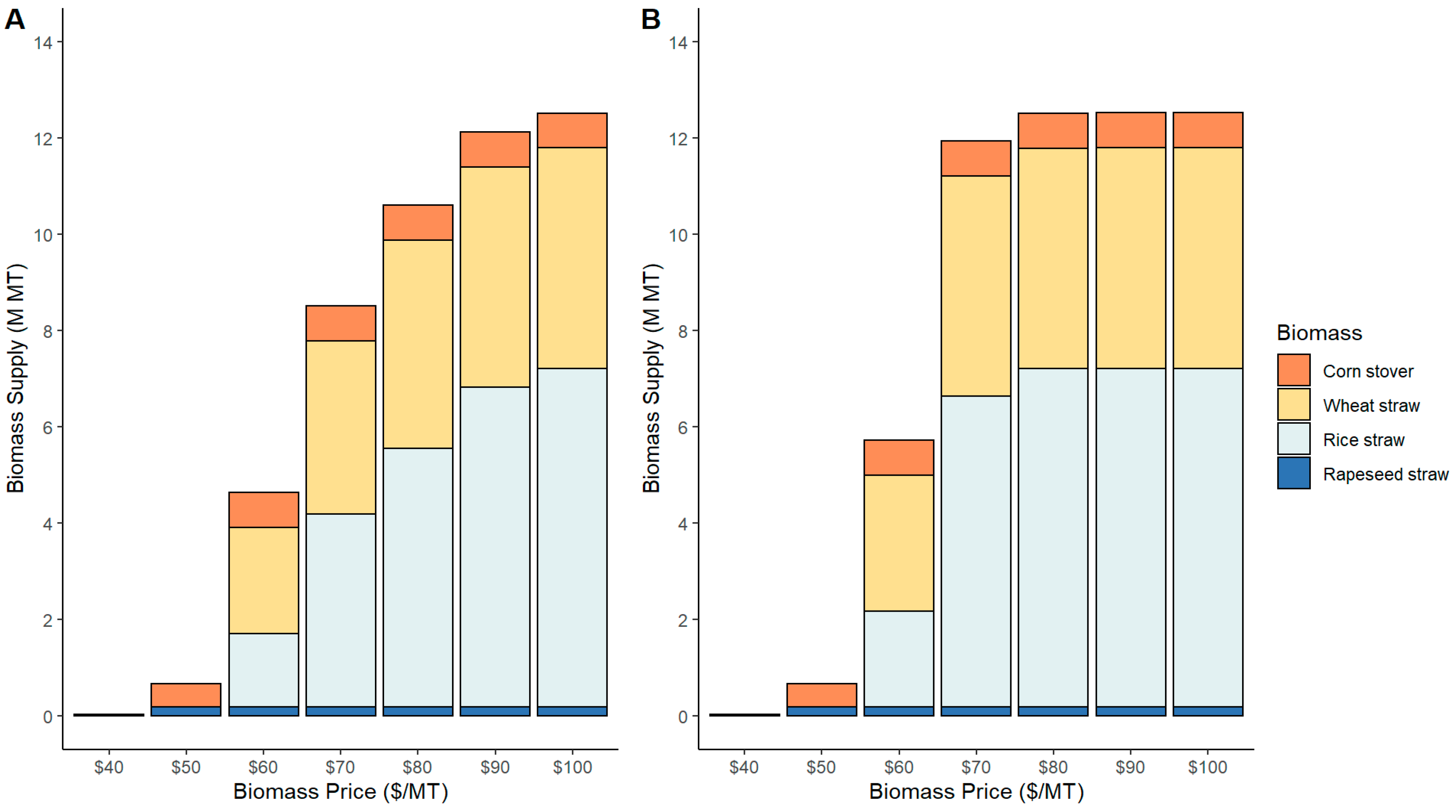
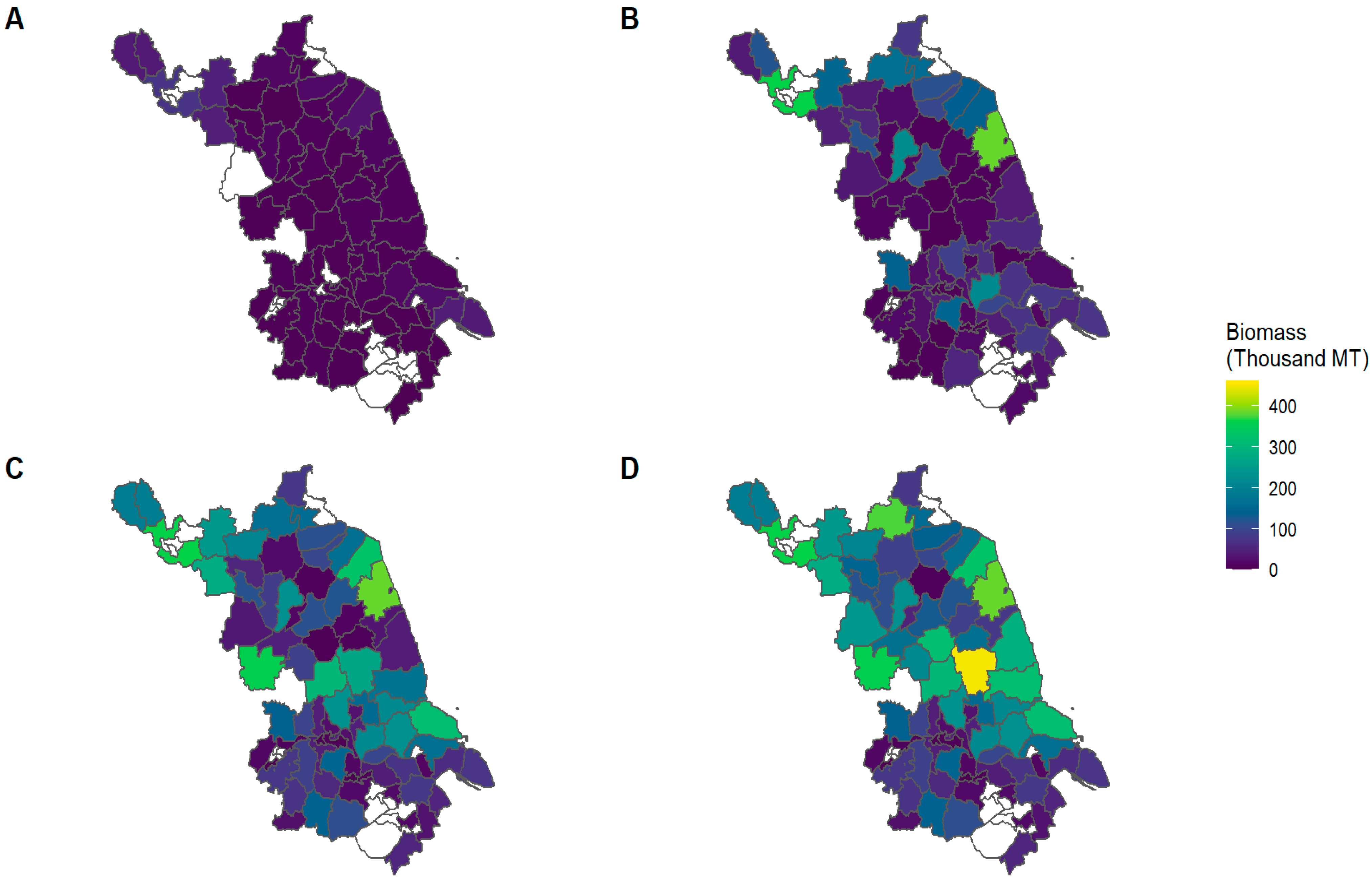
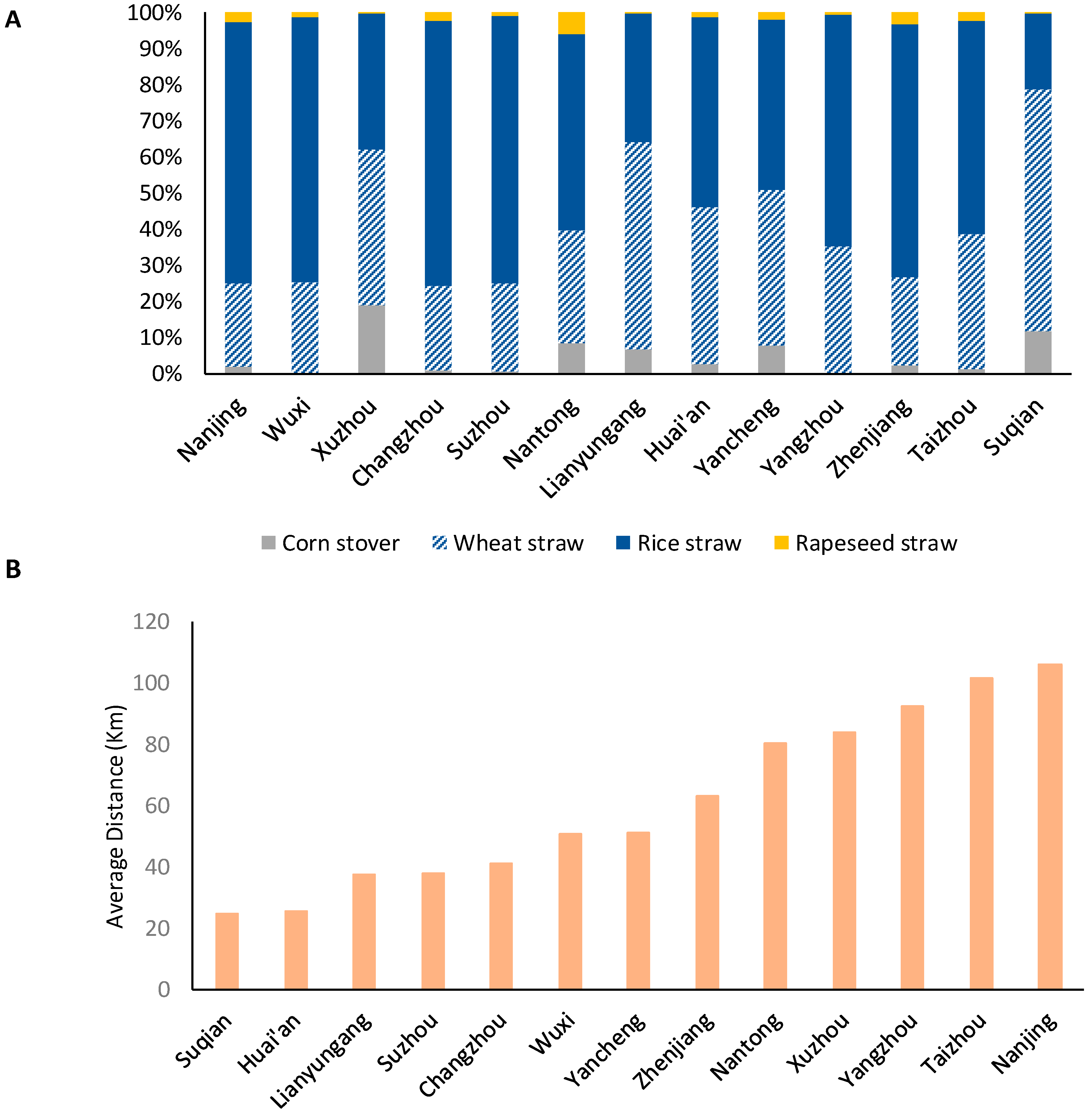
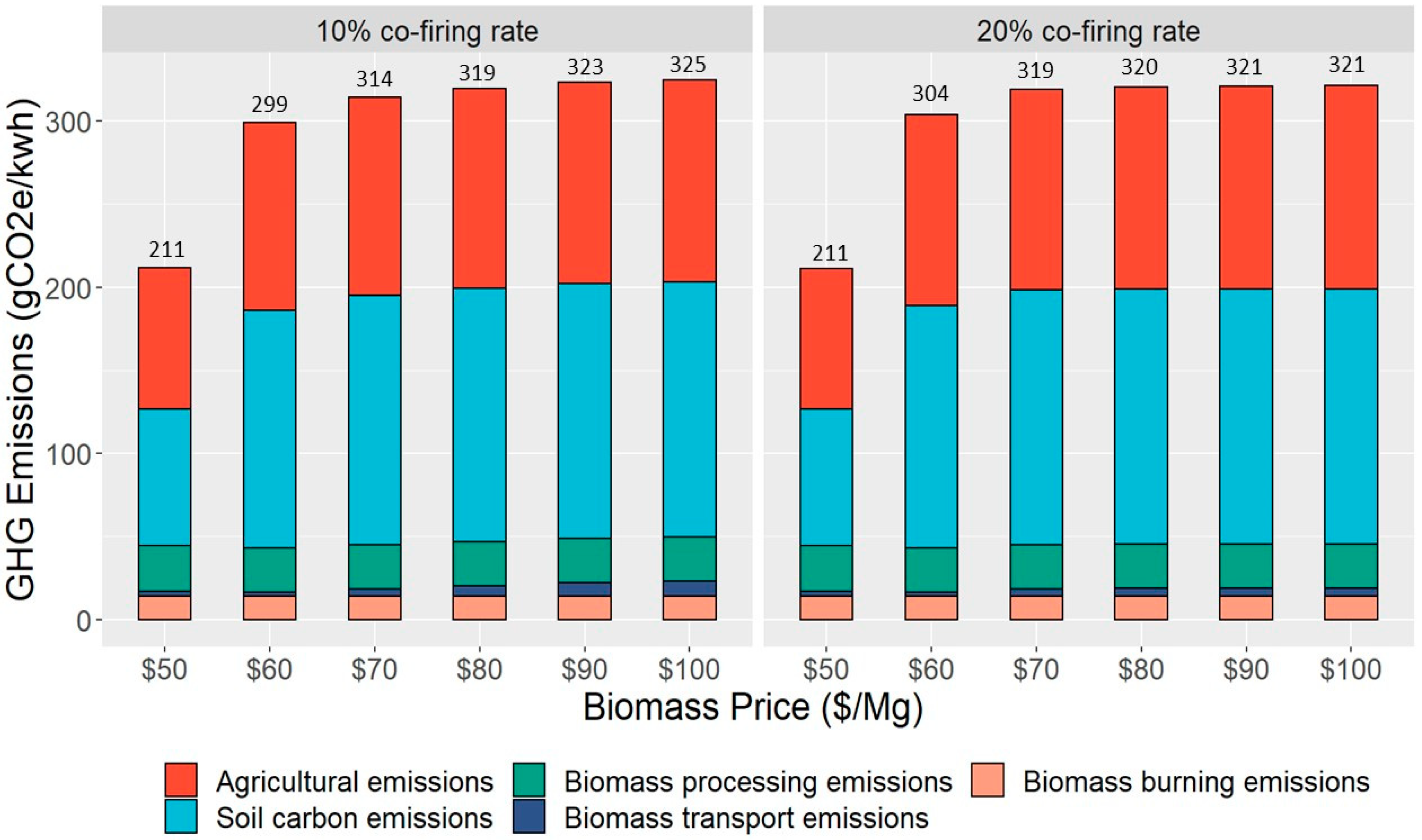
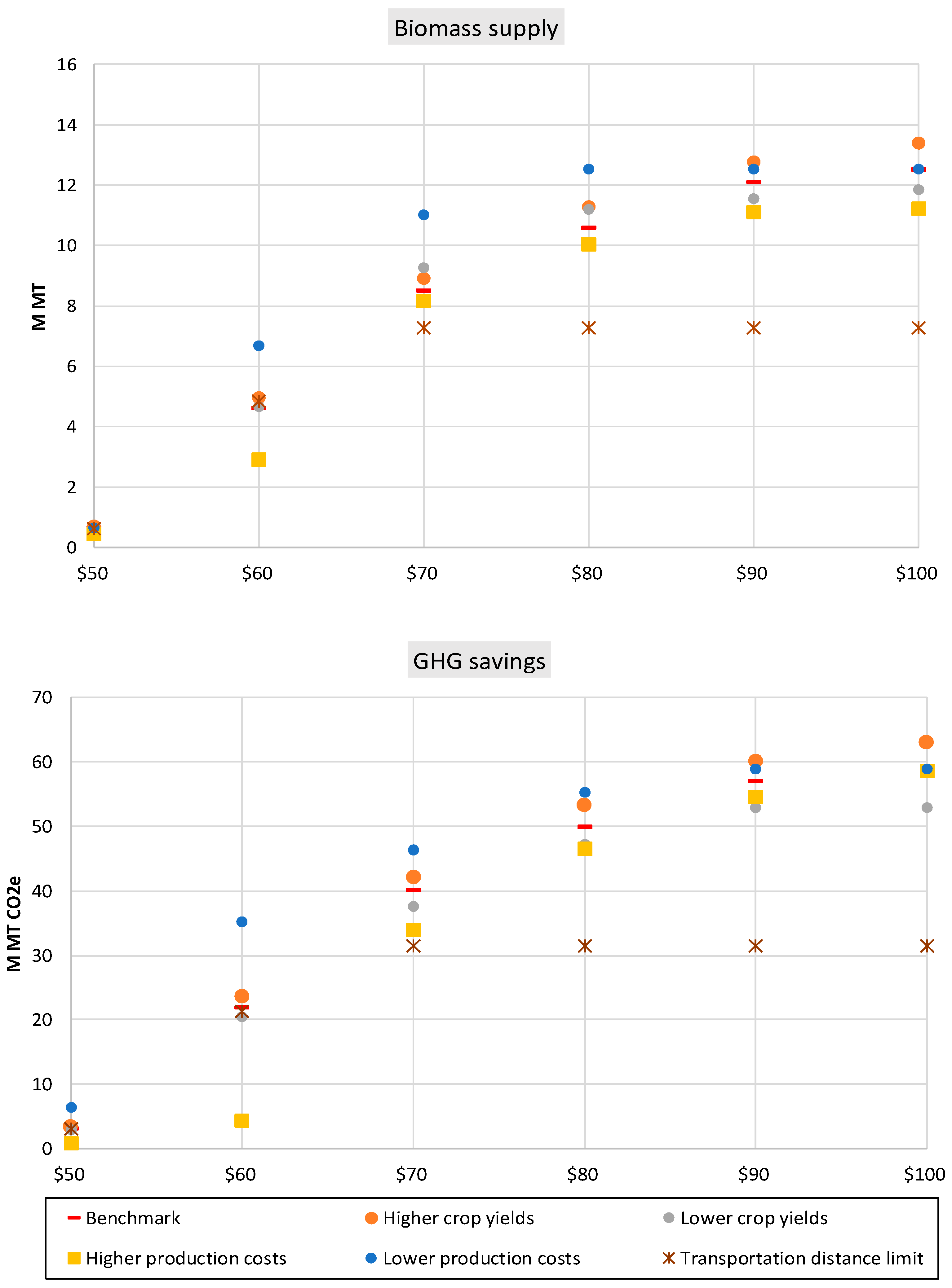
| Biomass Price | Coal Replacement (1000 MT) | Agricultural Producer Surplus (USD M) | GHG Emissions (M MT CO2e) | |||||
|---|---|---|---|---|---|---|---|---|
| Emissions from Coal-Based Electricity (a) | GHG Avoided from Coal Displacement (b) | Emissions from Biopower (c) | Emissions from Biomass Open Burning (d) | Net GHG Savings (e) = (b) − (c) + (d) | ||||
| 10% Co-firing | USD 0 | 0 | 4244.02 | 426.97 | 0 | 0 | 0 | 0 |
| USD 50 | 534.77 | 4246.53 | 423.51 | 3.46 | 0.27 | 0.05 | 3.24 | |
| USD 60 | 3765.93 | 4260.70 | 402.61 | 24.36 | 2.71 | 0.39 | 22.03 | |
| USD 70 | 6914.94 | 4330.41 | 382.24 | 44.73 | 5.23 | 0.71 | 40.21 | |
| USD 80 | 8621.44 | 4424.91 | 371.20 | 55.76 | 6.63 | 0.88 | 50.02 | |
| USD 90 | 9854.93 | 4539.22 | 363.23 | 63.74 | 7.67 | 1.01 | 57.09 | |
| USD 100 | 10,172.83 | 4655.14 | 361.17 | 65.80 | 7.95 | 1.04 | 58.89 | |
| 20% Co-firing | USD 0 | 0 | 4244.02 | 426.97 | 0 | 0 | 0 | 0 |
| USD 50 | 534.95 | 4246.54 | 423.51 | 3.46 | 0.27 | 0.05 | 3.24 | |
| USD 60 | 4643.43 | 4262.49 | 396.93 | 30.03 | 3.40 | 0.48 | 27.11 | |
| USD 70 | 9703.62 | 4353.37 | 364.20 | 62.76 | 7.45 | 0.99 | 56.31 | |
| USD 80 | 10,172.06 | 4471.45 | 361.17 | 65.79 | 7.85 | 1.04 | 58.99 | |
| USD 90 | 10,175.59 | 4584.44 | 361.15 | 65.82 | 7.86 | 1.04 | 59.00 | |
| USD 100 | 10,176.15 | 4706.89 | 361.15 | 65.82 | 7.86 | 1.04 | 59.00 | |
Disclaimer/Publisher’s Note: The statements, opinions and data contained in all publications are solely those of the individual author(s) and contributor(s) and not of MDPI and/or the editor(s). MDPI and/or the editor(s) disclaim responsibility for any injury to people or property resulting from any ideas, methods, instructions or products referred to in the content. |
© 2023 by the author. Licensee MDPI, Basel, Switzerland. This article is an open access article distributed under the terms and conditions of the Creative Commons Attribution (CC BY) license (https://creativecommons.org/licenses/by/4.0/).
Share and Cite
Wang, W. Integrated Assessment of Economic Supply and Environmental Effects of Biomass Co-Firing in Coal Power Plants: A Case Study of Jiangsu, China. Energies 2023, 16, 2725. https://doi.org/10.3390/en16062725
Wang W. Integrated Assessment of Economic Supply and Environmental Effects of Biomass Co-Firing in Coal Power Plants: A Case Study of Jiangsu, China. Energies. 2023; 16(6):2725. https://doi.org/10.3390/en16062725
Chicago/Turabian StyleWang, Weiwei. 2023. "Integrated Assessment of Economic Supply and Environmental Effects of Biomass Co-Firing in Coal Power Plants: A Case Study of Jiangsu, China" Energies 16, no. 6: 2725. https://doi.org/10.3390/en16062725
APA StyleWang, W. (2023). Integrated Assessment of Economic Supply and Environmental Effects of Biomass Co-Firing in Coal Power Plants: A Case Study of Jiangsu, China. Energies, 16(6), 2725. https://doi.org/10.3390/en16062725






